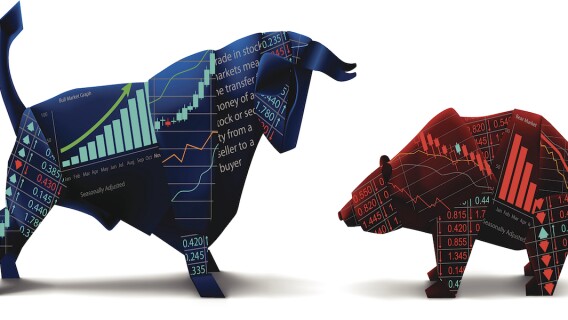The name of the game on Wall Street these days is uncertainty.
Uncertainty about the direction of the market, the path of inflation, tariffs, and frankly, uncertainty about the economy as a whole.
Jerome Powell acknowledged as much in the Fed meeting last week (it’s also reflected in the Fed’s Summary of Economic Projections, which shows higher uncertainty around GDP growth, inflation, and employment—essentially reversing the last two years’ worth of “certainty” gains).
Given the rising uncertainty, Wall Street banks have begun lowering year-end targets for the S&P 500 (Goldman lowered their target from 6,500 to 6,200 a few weeks ago; Barclays just dropped their target to 5,900 yesterday) and Wall Street is again considering recession and stagflation risks.
Against that backdrop, both the S&P 500 and the Nasdaq entered correction territory, falling more than 10% between February 19 and mid-March.
But with concerns about the broader economy growing, it’s fair to wonder whether this is a correction that will soon be put behind us or if it’s the early innings of a new bear market.
[text_ad]
With the obvious caveat that much of this hinges on policy decisions from President Trump, I do think we can look back at the start of 2022’s bear market and the 2024 correction in the Nasdaq to get a better sense of how the market is currently postured.
It won’t be enough for a definitive answer, but it should be enough to favor one scenario over the other.
The Correction of 2024 and the Bear Market of 2022
The chart above is a four-year weekly chart of the Nasdaq Composite. It includes Bollinger Bands (solid green lines) around a 20-week simple moving average (dotted line), a 50-week moving average, and a 200-week moving average.
The chart also includes the Relative Strength Index (RSI), which measures overbought and oversold conditions, and On Balance Volume (OBV), which measures momentum.
My instant reaction? It sure looks a lot more like 2022 than 2024 to me.
The Bear Market vs. Now
As you can see in the chart, the bull market of 2021 saw the Nasdaq riding higher on the 20-week SMA, occasionally testing below it and generally being bound on the upside by the upper Bollinger Band (2 standard deviations away from the 20-week), all while trading consistently above an uptrending 50-week moving average.
RSI was periodically tagging very overbought conditions (normal in a bull market) while staying at or above the 50 level, and OBV was trending gradually higher.
When 2022 (and the associated bear market) hit, the Nasdaq cracked below the 20-week line and quickly fell through the 50-week moving average.
The 20-week line, which had previously been rising support, turned into falling resistance, largely capping attempts by the Nasdaq to break higher. (Just as it did on the way up, however, the Nasdaq would occasionally poke through the 20-week line before reverting to its primary channel.)
The 50-week line flattened (February and March) and turned lower (end of April).
Visually, the similarities between January of 2022 and the last few weeks should be quite apparent.
The 50-week line is flattening out and the 20-week is now downtrending.
The index is below the 50-week moving average, which became resistance in 2022 after the Nasdaq tested it and was rejected; a similar test is underway as I write this.
In 2022, RSI dropped below 50 and stayed there until shortly after the market bottomed in October while OBV began trending lower.
Similarly, the RSI has recently dropped below 50, although it’s too early to tell whether OBV has entered a downtrend (would need to see a lower high and a lower low).
2024’s Correction vs. Now
Aside from the scale of the move (13.1% in summer of 2024 vs. 13.7% in 2025), I don’t see much in common with 2024’s correction right now.
All three periods share similar setups (riding the 20-week higher, positive momentum on OBV, above 50 on RSI), and all three periods saw a break below the 20-week moving average (impossible to correct lower without that), but that’s where the similarities end.
2024’s correction never dragged the RSI into oversold territory, nor did it threaten the 50-week moving average at all.
In fact, the 50-week moving average didn’t even flatten during 2024’s correction; it remained uptrending for the duration.
In other words, the correction in 2024 was against the backdrop of a market that still had a lot of signs of a technical uptrend.
So, in my assessment, it looks more like the start of the 2022 bear market than a repeat of last summer.
But officially, I have to grade it an “incomplete.”
We should have a lot more clarity a little over a week from now, after the April 4 close.
Not only will we have another two weekly closes on our chart telling us whether the index passed or failed its test of the 50-week average, but we’ll also have more data points on the OBV and RSI as well.
The longer they are bearish (RSI held below 50, OBV trending lower), the more it looks like a bear market and not a correction/recovery.
But, more importantly, April 4 is also the first weekly close after America’s tariff “Liberation Day” (or day of reckoning) on April 2.
If President Trump lets the market feel the full weight of the tariff hammer, Wall Street has to assume that the “Trump put” is out of play, and there’s probably more downside ahead.
In the near term, if you’re overly worried about it, assess your stops (or add some), trim positions that have gotten too large, and maybe keep some extra powder dry for when the markets signal an all clear.
[author_ad]


